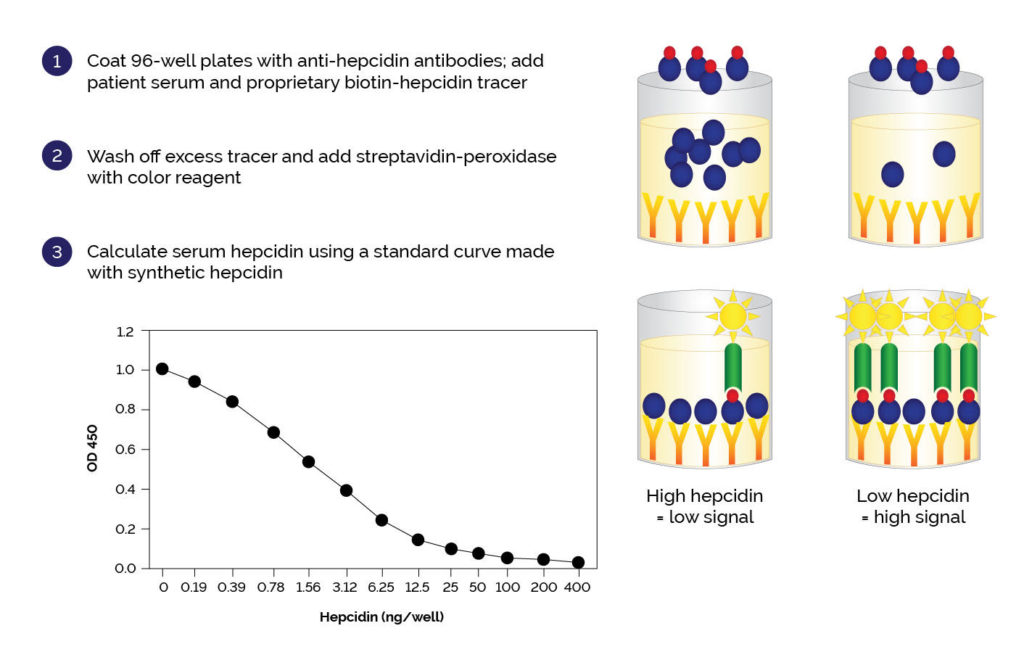HEPCIDIN – FAQs

Visit IntrinsicDx, the CLIA certified and CAP accredited clinical laboratory of Intrinsic LifeSciences, for information on using the Intrinsic Hepcidin IDx™ test for your patient testing needs.
We are the world’s leading provider of innovative in vitro diagnostics for iron overload diseases, anemia, and iron-related inflammatory diseases & offer the only CLIA-certified immunoassay for the key hormone regulating plasma iron levels in the human body.
Hepcidin Research Use Only (RUO) Test Information
Yes. The Intrinsic LifeSciences laboratory developed Hepcidin test and tracer are patented
(Patent # 7,723,063 and 7,745,162).
Currently the hepcidin assay is not FDA approved. However, it has been validated in several peer-reviewed studies and is marketed as a Research Use Only assay. It is offered for academic, clinical, government and pharmaceutical customers, worldwide.
No, this is an RUO test. To order our diagnostic test, the Intrinsic Hepcidin IDxTM Test, please go to IntrinsicDx - Order Tests / Specimen Collection & Shipping Instructions.
Hepcidin is measured in plasma, serum, urine and other body fluids using a patented tracer and a competitive enzyme-linked immunosorbent assay (ELISA).

src="http://ilswp88.staging.wpengine.com/wp-content/uploads/2020/11/Picture1-300x218.png" alt="" width="250" />The yellow Y-shaped figures represent the hepcidin antibodies, the blue balls represent serum hepcidin, the blue and red balls represent the ILS patented biotinylated hepcidin tracer molecule, and the green figures represent the detection reagent which emits a signal that is detected and quantified.
In serum and plasma, hepcidin is stable for at least 6 years when samples are stored either at -80°C or -20°C. In urine, hepcidin is stable for 6 months at -80°C.
Hepcidin concentrations can be reported as either nM or ng/ml. To convert between the two units use the following calculations: 1 nM = 2.789 ng/ml or 1 ng/ml = 0.358 nM.
Hepcidin could be present in virtually any body fluid. To date we have measured hepcidin in plasma, serum, urine, saliva, cerebral spinal fluid, cord blood, amniotic fluid and peritoneal dialysis fluid.
Sample Collection for Hepcidin Research Use Only (RUO) Testing
Serum samples: Collect blood from fasting subjects in a red top or yellow top serum collection tube. Immediately after blood collection, place the tubes upright in a rack and allow blood to clot at room temperature for 30 minutes to 2 hours. Centrifuge the tubes at 1500xg for 15 minutes and collect supernatant.
Plasma samples: Collect blood from fasting subjects in a tube containing either lithium heparin or EDTA (purple top). Invert tubes several times immediately after collection and place horizontally on a platform rocker at moderate speed for 30 minutes to 2 hours at room temperature. Centrifuge the tubes at 1500xg for 15 minutes and collect supernatant.
Transfer 0.25 ml into a clean 0.5 to 2.0 ml cryogenic vial and store frozen until shipment. Smaller sample volumes can be accepted upon request, particularly for infant and pediatric studies.
Urine: collect first morning urine at mid-stream and transfer 0.25 ml into a clean 0.5 to 2.0 ml cryogenic vial and store frozen until shipment.
After collection, store serum, plasma and urine samples at -80°C (or at -20oC) until shipment. Do not freeze whole blood. Always transfer serum or plasma to another vial before freezing.
-samples stored at room temperature (15-30oC) for longer than 24 hours.
-samples that thawed during transport.
-samples that are largely hemolyzed.
-samples that have been insufficiently clotted.
Request RUO Hepcidin Testing
Contact us at Phone: 858-459-1758 or [email protected] or request a quote
Shipping Information
Place sample vials in a primary receptacle (e.g. a cardboard cryogenic storage box), which should be placed in a secondary package (such as zip lock bag) that includes absorbent material. If leakage occurs during transport, the absorbent material will contain the spill. Place secondary container into the rigid outer package such as an insulated, leak-proof, thermal shipping container and fill the container with dry ice. Please use sufficient amount of dry ice to allow for a 2 day transit time, in case of a delivery delay.
Finally, please include the sample manifest (list of samples) with each shipment.
Ship samples by Priority Overnight delivery. Always consult national and international regulations for the safe shipment of biological substances on dry ice. We routinely receive international shipments from World Courier and FedEx.
Please ship on Monday-Thursday. Our office is closed on weekends and during US national holidays. Contact your preferred carrier for additional shipment instructions and schedules.
Shipping address
Intrinsic LifeSciences
505 Coast Boulevard South, Suite 408
La Jolla, CA 92037
Phone: 858-459-7788